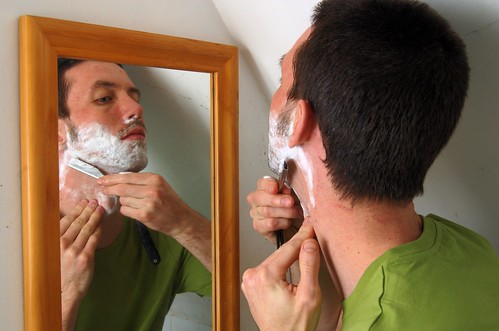The 3-2-1 shadow work process isn't a depth practice, but it is a very useful tool for looking into shadow material.
Practice: The 3-2-1 Shadow Process
Own Your Shadow Or Be Owned By It
In this practice we begin the process of re-owning our shadow. We'll FACE our shadow in 3rd-person; we'll TALK to our shadow in a 2nd-person dialogue; and we'll BE our shadow in 1st-person. Face it, Talk to it, Be it...It's that simple.
To Practice The 3-2-1 Process
1. Choose an experience in your life that you want to work with. It's often easier to begin with a person with whom you have difficulty (e.g., lover, relative, boss). This person may irritate, disturb, annoy, or upset you. Or maybe you feel attracted to, obsessed with, infatuated with, or possessive about this person. In any case, choose someone with whom you have a strong emotional charge, whether positive or negative.
2. Face It : Now, imagine this person. Describe those qualities that most upset you, or the characteristics that you are most attracted to using 3rd-person language (he, she, it). Talk about them out loud or write it down in a journal. Take this opportunity to "let it out." Don't try to be skillful or say the right thing. There is no need to sugar-coat your description. The person you are describing will never see this.
3. Talk to It: Begin an imaginary dialogue with this person. Speak in 2nd person to this person (you). Talk directly to this person as if he or she were actually there in the room with you. Tell them what bothers you about them. Ask them questions such as "Why are you doing this to me?" "What do you want from me?" "What are you trying to show me?" "What do you have to teach me?" Imagine their response to these questions. Speak that imaginary response out loud. Record the conversation in your journal if you like.
4. Be It: Become this person. Take on the qualities that either annoy or fascinate you. Embody the traits you described in "Face It." Use 1st-person language ( I, me, mine). This may feel awkward, and it should. The traits you are taking on are the exact traits that you have been denying in yourself. Use statements such as "I am angry," "I am jealous," "I am radiant." Fill in the blank with whatever qualities you are working with: "I am__________."
5. To complete the process, notice these disowned qualities in yourself. Experience the part of you that is this very trait. Avoid making the process abstract or conceptual: just BE it. Now you can re-own and integrate this trait in yourself.
Practice Genealogy
The 3-2-1 process is a simple and effective tool for working with the shadow. It was developed by Ken Wilber and his associates at Integral Institute, and is a recommended practice in the Integral Life Practice Starter Kit. This practice is designed to provide a quick, easy, and effective method to work with our disowned selves. There are numerous techniques to deal with the shadow, but most require the assistance of a professional therapist. The 3-2-1 Process can be used by anyone anywhere at any time, and at no cost.
The 3-2-1 Process helps you uncover your shadow and integrate unconscious thoughts and emotions, so you can become more healthy and whole. It takes an extraordinary amount of energy to keep aspects of ourselves hidden in shadow. The energy it takes to repress or deny aspects of ourselves could potentially be employed in other ways; perhaps even a developmental transformation. When we shine a light on our shadow and work to integrate disowned aspects of ourselves, we liberate the energy we were using to hide from ourselves, and more energy is never a bad thing.
This process uses shifts in perspectives as a way of identifying and integrating shadow material. 3-2-1 refers to 3rd person, 2nd person, and 1st person perspectives. When an aspect of the self poses a threat, the self seeks to distance itself from that threat. As a result, the self concludes, "That is not me. That is someone else." The self exports that trait that threatens it onto someone else. We can disown both lower and higher aspects of ourselves. In either case, we project it as "You." You are angry. You are being selfish. You are worthy. In other words, we displace it from a 1st - person "I" to a 2nd- person "You."
If the threat of this emotion or situation becomes so great that it requires a total rejection, we push it away into a 3rd- person "It." At that point, the shadow arises as a sense of irritation, reactivity, fear, or aversion toward things, but we usually do not understand why we feel this way.
And meditation alone won't fix this, most forms of meditation won't even help; in fact, they may make things worse. Meditation suggests dis-identification from experience ("You are not your thoughts. etc."). But to integrate the shadow, we need to RE-identify with disowned dimensions of our experience and ourselves. We can only truly let go of something that we have first owned. Healthy disidentification is only possible once we have re-owned, re-associated, and re-identified with the disowned parts of ourselves. For this reason, there is no substitute for shadow work.
The 3-2-1 Process can be used in various ways. For beginners, try it out once a week for roughly 30 minutes and work with the biggest issue of your week. For more advanced practitioners, begin applying the 3-2-1 Process to dreams and issues of your daily life.
You can also opt to use the "empty chair" rather than a journal. Just replace the journal with an actual chair in the exercise outlined above. Place this chair across from you, and imagine the person you have chosen to work with sitting in it. In "Face It" (3), simply describe the qualities of this person that provoke you. Talk about them in front of them. In "Talk to It" (2), dialogue with this person. When it is their turn to respond, sit in the other chair and respond as that person. Go back and forth between chairs until the dialogue is over. In "Be It" (1), sit as the other and be the person that triggers you. Embody the qualities that irritate or fascinate you and speak as this person using "I" statements: "I am ________."
 Contributor:
Contributor: 













